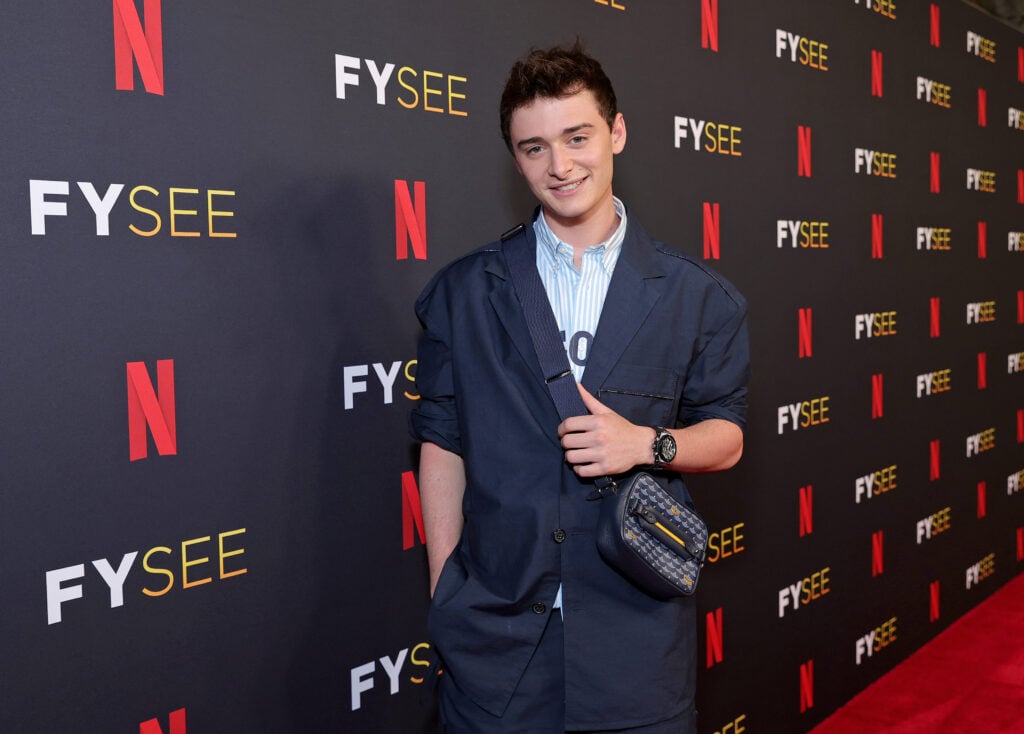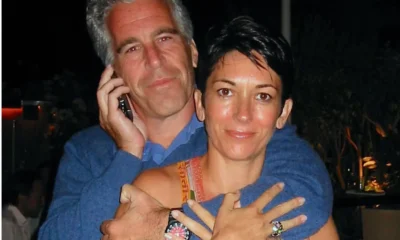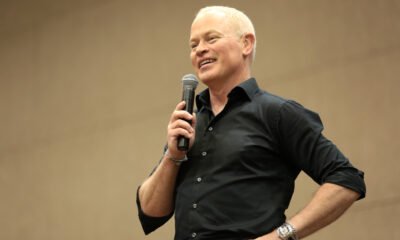Entertainment
Noah Schnapp Caught Liking Islamophobic, Queerphobic Content Defending Bombing of Gaza on November 7, 2023 at 8:52 pm The Hollywood Gossip

Last week, we reported on Amy Schumer’s series of vile posts, some comparing all Gazans to rapists. The death toll in Gaza has surpassed 10,000, with the UN referring to the warzone as a “children’s graveyard.”
She accused people pushing back or calling for an end to the ongoing bombing of Palestinian civilians of antisemitism, even though thousands of Jewish protesters have taken these humanitarian stances.
At the time, we noted how Stranger Things actor Noah Schnapp had disappointed fans by cheering on Schumer against the “haters.”
Now, Schnapp is under fire again for liking some truly horrific posts — most notably, a cringe skit that manages to be both Islamophobic and queerphobic at the same time.
Noah Schnapp attends Netflix’s Stranger Things ATAS Official Screening at Raleigh Studios Hollywood on May 27, 2022. (Photo Credit: Emma McIntyre/Getty Images for Netflix)
The red flags have been up for weeks
As several social media users have joked, the Demogorgon that took Will Byers may have had the right idea.
The Stranger Things actor who portrays that character seems to have gone off the deep end in recent weeks.
For most, the first warning sign was when he applauded Amy Schumer’s horrific posts. It was, at best, absolutely tone deaf.
Noah Schnapp encourages Amy Schumer to ignore the “haters” on Instagram. By “haters,” he means people expressing alarm and condemnation for her callous and bigoted posts during Israeli government’s bombing campaign in Gaza. (Image Credit: Instagram)
Sometimes, people cheer on their friends (or favorite stars, or whatever) even when they’re wrong.
Additionally, celebrity culture tends to adopt a “toxic positivity” mindset. It lumps body-shaming trolls into the same group as people with constructive criticism or honest pushback. And it labels them all “haters.”
That’s why Schumer suggested that people opposed to the ethnic cleansing in Gaza simply don’t find her attractive. And perhaps it’s why Schnapp was so eager to cheer her on.
Amy Schumer posted a catch-all reply to criticisms of her abhorrent posts in October of 2023. This is Part 2 of her reply, where she seems to speculate on why people “really” don’t like her posts. (Image Credit: Instagram)
This is more than rubbing elbows with Schumer
Schnapp seems to be going further than that, however. Like Schumer, he appears to be willfully conflating protests against the deadly bombing of homes, hospitals, and a university with antisemitism.
It is absolutely true that antisemitism spikes when Israel is in the news. And, certainly, white nationalists have attempted to insert themselves into the narrative by condemning Israel. For all of the wrong reasons.
But it is dishonest to pretend that all or most or even a substantial portion of protesters are doing so out of antisemitism. Especially because white nationalists do not mourn the Gazan dead. They just also hate Jews, and hope to pin war crimes committed by the few onto an entire demographic.
Actor Noah Schnapp attends the 24th Annual Screen Actors Guild Awards at The Shrine Auditorium on January 21, 2018 (Photo Credit: Frederick M. Brown/Getty Images)
It’s clear that Schnapp understands that, no, the face of people opposing the slaughter of Palestinians in their homes and hospitals aren’t Nazis.
His “likes” make that clear enough.
On Sunday, an author by the name of Noa Tishby shared a deeply offensive “satirical” skit on Instagram. The video depicts a fake news show with clearly LGBTQ+ interviewers speaking to a grotesquely offensive strawman who is meant to represent Hamas.
In this Instagram screenshot, we can see that Noah Schnapp “liked” an Islamophobic, queerphobic “satirical” video amidst the ongoing bombing of Gaza. (Image Credit: Instagram)
A bigoted skit
The two chant “From the river to the sea, Palestine will be free,” an aspirational rhyme that calls for Palestinian liberation from apartheid.
This pair of interviewers quip that “everyone is welcome, LGBTQH…” making it clear that the “H” stands for Hamas.
They interview a fake member of Hamas, seemingly not understanding as he threatens to kill them as “infidels.”
Noah Schnapp attends Variety Power of Young Hollywood at NeueHouse Los Angeles on August 10, 2023. (Photo Credit: Kevin Winter/Getty Images)
It’s the sort of evil, racist nonsense that you’d see in 2002 in the wake of 9/11.
But it’s 2023 and people are still doing it.
All that’s changed is video quality — and the tone of the homophobia has changed to be less direct and more insidious.
In early 2023, Noah Schnapp came out as gay over TikTok. (Image Credit: TikTok)
The call is coming from inside the house
Which does make it extra weird that Noah Schnapp, who came out as gay less than one year ago, is sharing this.
Internalized homophobia isn’t just for folks who are in the closet. And even within the LGBTQ+ community, queerphobia can be a huge problem.
You know how a woman with internalized misogyny might say “I’m not like other girls” or “girls are just too much drama!” Well, there are folks in the LGBTQ+ community with similarly cringe takes.
Noah Schnapp attends the 2023 CMT Music Awards at Moody Center on April 02, 2023. (Photo Credit: Jason Kempin/Getty Images)
Unfortunately, many marginalized communities have these issues. It’s so easy to disparage each other while begging for crumbs of respect from bigots.
And it looks like Schnapp either likes this stereotype of LGBTQ+ folks — or was happy to ignore it while enjoying the Islamophobia.
We regret to inform you that this is not the end of Schnapp’s tasteless Instagram activity.
As this Instagram screenshot illustrates, Noah Schnapp reposted a video of far-right commentator Ben Shapiro. (Image Credit: Instagram)
Gross!
Ben Shapiro is one of the most outspoken (and all-around unpleasant) voices in just about any sort of political discourse.
Shapiro is also the architect of a lot of anti-LGBTQ+ discourse. He promotes outright bigotry and fearmongering.
Under any circumstances, Schnapp sharing (and thus endorsing) a video by this wretched little man would be disappointing at best. The context — the massacre of Palestinians in Gaza — makes it much worse. And it’s also wildly hypocritical.
People sift through the smouldering rubble of buildings destroyed in an Israeli strike on the Bureij refugee camp in the central Gaza Strip on November 2, 2023. (Photo Credit: MAHMUD HAMS/AFP via Getty Images)
The “point” of the cringe satirical video that Schnapp apparently liked so much was that people were supporting people who would dislike them, or would be their enemies.
That’s wrong.
It’s also totally hypocritical and shows zero self-awareness on Schnapp’s part. So let’s break it down.
Noah Schnapp speaks onstage during Netflix’s Stranger Things ATAS Official Screening at Raleigh Studios Hollywood on May 27, 2022. (Photo Credit: Emma McIntyre/Getty Images for Netflix)
Painting Muslims as automatically homophobic is bigoted — and a lie
Random LGBTQ+ people in the US (or other Americans) are not “enemies” of the people of Gaza. Palestinians are just people — people who have lived under apartheid and increasingly cruel rule in their own country for generations.
Implying that all of the people of Gaza are homophobic and would not appreciate the vocal support of Westerners is absurd. Saying that they “must” be homophobic because they are Muslim is Islamophobic.
This video that Schnapp liked so much seems to be an effort to blur the lines between Hamas and the rest of the citizens for Hamas. And to reduce sympathy for the victims of the bombing campaign by portraying them as violent bigots.
Palestinian citizens inspect damage to their homes caused by Israeli airstrikes on October 10, 2023 in Gaza City, Gaza. Almost 800 people have died in Gaza, and 187, 000 displaced, after Israel launched sustained retaliatory air strikes after a large-scale attack by Hamas. (Photo Credit: Ahmad Hasaballah/Getty Images)
Also, it’s great to remember that there are LGBTQ+ people in Gaza. Many thousands of them. Fewer of them, now.
A mournful post that we saw last month, from a Palestinian man in Gaza who wrote that the love of his life had died. And that, without him, he would not leave his home and just let the IDF kill him, too. That post will haunt us all for a while.
Not to mention that, in the past couple of weeks, the IDF has almost certainly slaughtered more LGBTQ+ people than Hamas has since its inception.
Amy Schumer used a video of Dr. Martin Luther King Jr. discussing Israel. Bernice King responded with a quote-tweet, expressing confidence that her late father would call for an end to the bombing of Gaza. (Image Credit: Twitter)
Look into the mirror
There is another thing to point out: the skit that Schnapp seemed to enjoy was saying that people shouldn’t be cheering on their “enemies.”
But the Stranger Things actor was doing exactly that when he posted and thus endorsed Shapiro. Shapiro is unequivocally opposed to Schnapp’s rights as a gay man. He has made a career of it.
Maybe that won’t get the same malicious laughter that the early-seasons-Always-Sunny looking Islamophobic video elicited, but it’s true. We wish that Schnapp had chosen to be a better person.
Noah Schnapp Caught Liking Islamophobic, Queerphobic Content Defending Bombing of Gaza was originally published on The Hollywood Gossip.
Last week, we reported on Amy Schumer’s series of vile posts, some comparing all Gazans to rapists. The death toll …
Noah Schnapp Caught Liking Islamophobic, Queerphobic Content Defending Bombing of Gaza was originally published on The Hollywood Gossip.
The Hollywood Gossip Read More
Entertainment
What We Can Learn Inside 50 Cent’s Explosive Diddy Documentary: 5 Reasons You Should Watch

50 Cent’s new Netflix docuseries about Sean “Diddy” Combs is more than a headline-grabbing exposé; it is a meticulous breakdown of how power, celebrity, and silence can collide in the entertainment industry.
Across its episodes, the series traces Diddy’s rise, the allegations that followed him for years, and the shocking footage and testimonies now forcing a wider cultural reckoning.

1. It Chronicles Diddy’s Rise and Fall – And How Power Warps Reality
The docuseries follows Combs from hitmaker and business icon to a figure facing serious criminal conviction and public disgrace, mapping out decades of influence, branding, and behind-the-scenes behavior. Watching that arc shows how money, fame, and industry relationships can shield someone from scrutiny and delay accountability, even as disturbing accusations accumulate.

2. Never-Before-Seen Footage Shows How Narratives Are Managed
Exclusive footage of Diddy in private settings and in the tense days around his legal troubles reveals how carefully celebrity narratives are shaped, even in crisis.
Viewers can learn to question polished statements and recognize that what looks spontaneous in public is often the result of strategy, damage control, and legal calculation.
3. Survivors’ Stories Highlight Patterns of Abuse and Silence
Interviews with alleged victims, former staff, and industry insiders describe patterns of control, fear, and emotional or physical harm that were long whispered about but rarely aired in this detail. Their stories underline how difficult it is to speak out against a powerful figure, teaching viewers why many survivors delay disclosure and why consistent patterns across multiple accounts matter.
4. 50 Cent’s Approach Shows Storytelling as a Tool for Accountability
As executive producer, 50 Cent uses his reputation and platform to push a project that leans into uncomfortable truths rather than protecting industry relationships. The series demonstrates how documentary storytelling can challenge established power structures, elevate marginalized voices, and pressure institutions to respond when traditional systems have failed.
5. The Cultural Backlash Reveals How Society Handles Celebrity Accountability
Reactions to the doc—ranging from people calling it necessary and brave to others dismissing it as a vendetta or smear campaign—expose how emotionally invested audiences can be in defending or condemning a famous figure. Watching that debate unfold helps viewers see how fandom, nostalgia, and bias influence who is believed, and why conversations about “cancel culture” often mask deeper questions about justice and who is considered too powerful to fall.
Entertainment
South Park’s Christmas Episode Delivers the Antichrist

A new Christmas-themed episode of South Park is scheduled to air with a central plot in which Satan is depicted as preparing for the birth of an Antichrist figure. The premise extends a season-long narrative arc that has involved Satan, Donald Trump, and apocalyptic rhetoric, positioning this holiday episode as a culmination of those storylines rather than a stand‑alone concept.
Episode premise and season context
According to published synopses and entertainment coverage, the episode frames the Antichrist as part of a fictional storyline that blends religious symbolism with commentary on politics, media, and cultural fear. This follows earlier Season 28 episodes that introduced ideas about Trump fathering an Antichrist child and tech billionaire Peter Thiel obsessing over prophecy and end‑times narratives. The Christmas setting is presented as a contrast to the darker themes, reflecting the series’ pattern of pairing holiday imagery with controversial subject matter.
Public and political reactions
Coverage notes that some figures connected to Donald Trump’s political orbit have criticized the season’s portrayal of Trump and his allies, describing the show as relying on shock tactics rather than substantive critique. Commentators highlight that these objections are directed more at the depiction of real political figures and the show’s tone than at the specific theology of the Antichrist storyline.
At the time of reporting, there have not been widely reported, detailed statements from major religious leaders focused solely on this Christmas episode, though religion-focused criticism of South Park in general has a long history.
Media and cultural commentary
Entertainment outlets such as The Hollywood Reporter, Entertainment Weekly, Forbes, Slate, and USA Today describe the Antichrist arc as part of South Park’s ongoing use of Trump-era and tech-world politics as material for satire.
Viewer guidance and content advisory
South Park is rated TV‑MA and is intended for adult audiences due to strong language, explicit themes, and frequent use of religious and political satire. Viewers who are sensitive to depictions of Satan, the Antichrist, or parodies involving real political figures may find this episode particularly objectionable, while others may view it as consistent with the show’s long‑running approach to controversial topics. As with previous episodes, individual responses are likely to vary widely, and the episode is best understood as part of an ongoing satirical series rather than a factual or theological statement.
Entertainment
Sydney Sweeney Finally Confronts the Plastic Surgery Rumors

Sydney Sweeney has decided she is finished watching strangers on the internet treat her face like a forensic project. After years of side‑by‑side screenshots, “then vs now” TikToks, and long comment threads wondering what work she has supposedly had done, the actor is now addressing the plastic surgery rumors directly—and using them to say something larger about how women are looked at in Hollywood and online.

Growing Up on Camera vs. “Before and After” Culture
Sweeney points out that people are often mistaking normal changes for procedures: she grew up on camera, her roles now come with big‑budget glam teams, and her body has shifted as she has trained, aged, and worked nonstop. Yet every new red‑carpet photo gets folded into a narrative that assumes surgeons, not time, are responsible. Rather than walking through a checklist of what is “real,” she emphasizes how bizarre it is that internet detectives comb through pores, noses, and jawlines as if they are owed an explanation for every contour of a woman’s face.
The Real Problem Isn’t Her Face
By speaking up, Sweeney is redirecting the conversation away from her features and toward the culture that obsesses over them.
She argues that the real issue isn’t whether an actress has had work done, but why audiences feel so entitled to dissect her body as public property in the first place.
For her, the constant speculation is less about curiosity and more about control—another way to tell women what they should look like and punish them when they do not fit. In calling out that dynamic, Sweeney isn’t just defending herself; she is forcing fans and followers to ask why tearing apart someone else’s appearance has become such a popular form of entertainment.

 Entertainment2 weeks ago
Entertainment2 weeks agoWicked Sequel Disappoints Fans: Audience Verdict on For Good

 News3 weeks ago
News3 weeks agoYolanda Adams Questions Traditional Views on God’s Gender, Audience Reacts

 Entertainment2 weeks ago
Entertainment2 weeks agoAriana & Cynthia Say They’re in a ‘Non‑Demi Curious, Semi‑Binary’ Relationship… WTF Does That Even Mean?

 News3 weeks ago
News3 weeks agoEpstein Files to Be Declassified After Trump Order

 News4 weeks ago
News4 weeks agoTrump Throws Epstein Files at Clinton’s Door

 Entertainment4 weeks ago
Entertainment4 weeks agoAriana Grande’s Red Carpet: When Fans Forget Boundaries

 Entertainment3 weeks ago
Entertainment3 weeks agoHollywood’s Kiss or Miss Policy: Why Saying No Got Neal McDonough Blackballed

 Entertainment3 weeks ago
Entertainment3 weeks agoJimmy Cliff, Reggae Legend and Star of ‘The Harder They Come,’ Dies at 81


























